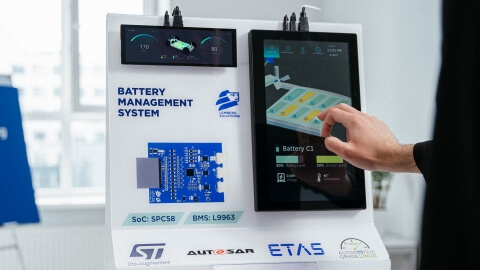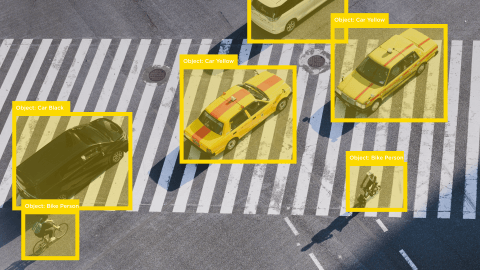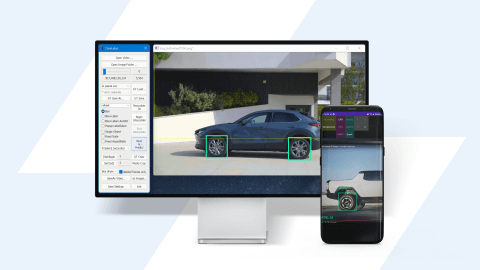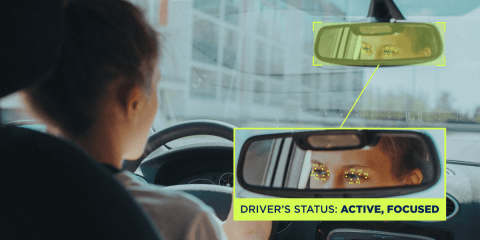Data labeling is one of the most important factors influencing the accuracy of ML and DL models. A well-designed data labeling process results in a first-rate training dataset. That is why data science engineers go the extra mile to ensure the high quality of the training data as a foundation of a successful AI project.
However, what is data labeling, and what are its benefits for data science solutions? Learn this in our article written by expert data science engineers sharing their knowledge and explaining how to label data efficiently.
What is data labeling?
Data labeling is the process of adding tags or labels to raw data, including videos, images, audio, text, and time serial data, as a part of the machine learning (ML) process. High-quality data labeling allows ML models to work more accurately and provide better predictions. Data labeling is a complex task since data science engineers frequently have to work with large datasets. Additionally, they aim to error-proof ML models, which highly depend on the accuracy of labeled data.
The labels represent an object class to help ML models learn to recognize specific classes within the data without labels. Poorly labeled data negatively affects the model’s accuracy, leading to numerous errors. Data labeling is even more important when used to train supervised learning models since their accuracy directly depends on the labeled input data.
Data labeling helps ML and DL models to recognize violators, detect traffic offence, recognize speech, and identify pedestrians to improve safety. Moreover, data labeling ensures that ML models work effectively in healthcare facilities, which simplifies patient monitoring.
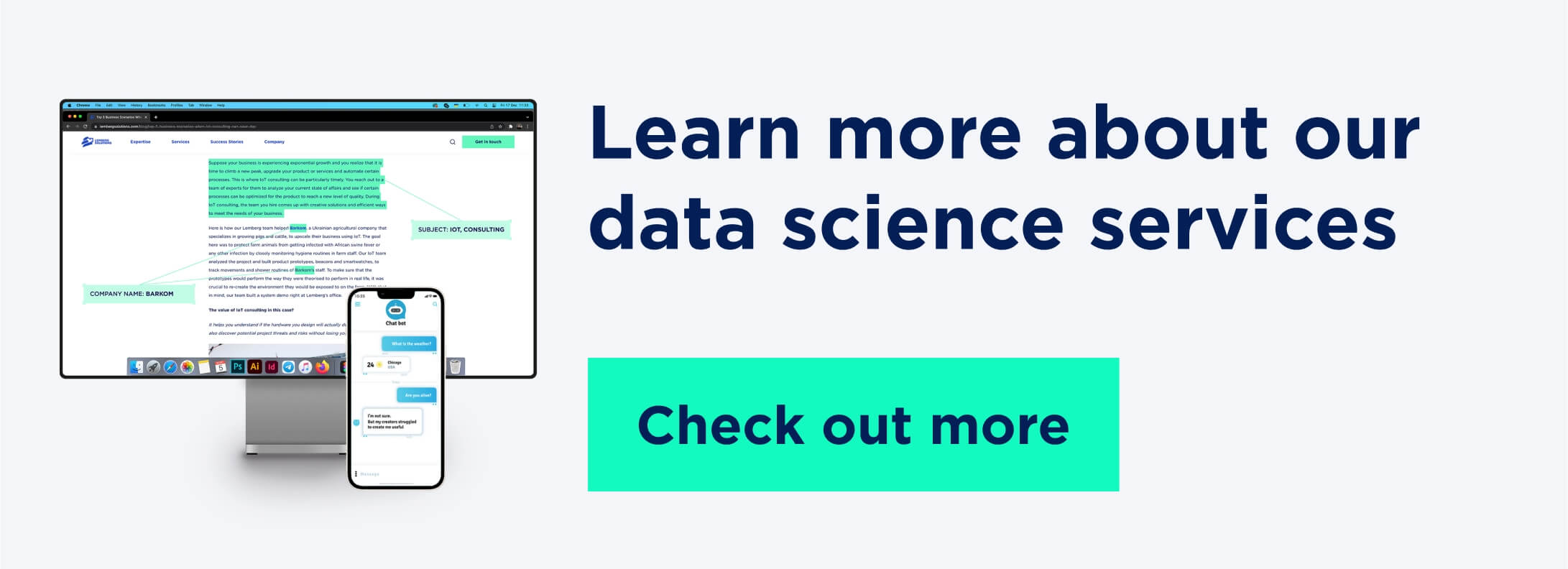
Benefits of effective data labeling
Data labeling provides an organized, clean data set prepared for ML model training and analysis. However, there are more advantages companies can get through effective data labeling, including:
1. Improved accuracy
Training a machine learning or deep learning model requires processing a lot of data, or else it won’t achieve the set objectives. The data engineers choose for training must be relevant and correct to ensure a model’s effectiveness. Machine learning labeling helps to categorize the data, eliminate the incorrect parts, and prepare needed data for training. This way, engineers enable improved prediction accuracy.
2. Human-in-the-loop
Data labeling under a data scientist’s supervision is more likely to make ML and DL models perform well. Human-in-the-loop helps to minimize errors and increase data accuracy. Besides, ML and DL models may require data context to provide better results. Data labelers work on data annotation to establish the necessary context for a model that won’t work efficiently without human intervention. Engineers enable constant model improvement by providing regular feedback to the algorithm and adjusting its operation.
3. Consistency
The consistency of labeled data means the coherence of annotations labelers assign while labeling the data. Consistency during data labeling ensures the ML and DL models will output correct results with reduced possibility of errors.
The expertise of a data science team influences the consistency degree. Labelers with hands-on experience in different industries provide more accurate annotations. Data labeling backed by expert knowledge allows to build high-functioning ML and DL models.
4. Compliance with regulations
Data science engineers and labelers adhere to data privacy practices and security regulations during labeling data and organizing data storage. Nowadays, vast amounts of data are collected for training ML models, which is why ensuring data protection becomes paramount. By delegating data labeling to professional data science labelers, organizations can ensure security and compliance with international standards when using data for model training.
5. Improvement of the existing model’s performance
Data labeling comes in handy when a company needs to improve an existing model’s accuracy by inputting more accurate data. Additional data labeling gives an understanding of why a model struggles to perform in the intended way. Data science engineers can identify the challenging areas and provide more labeled data to a model, improving machine learning models.
Data labeling influences several aspects of data science project development, including ML model accuracy, data security, and AI solution performance. Proper data labeling skills help data labelers contribute to a client’s project success, making a product user-friendly.
Common types of data labeling
Various data forms require different labeling techniques that would be the most effective for a particular project. Read below to learn how data labelers label different types of data, including images, videos, audio, text, and time series data.
Image labeling
Image labeling is the process of putting tags on images to establish specific object features for further model training. Read below to find out the main types of image labeling data scientists use for AI projects.
2D bounding boxes
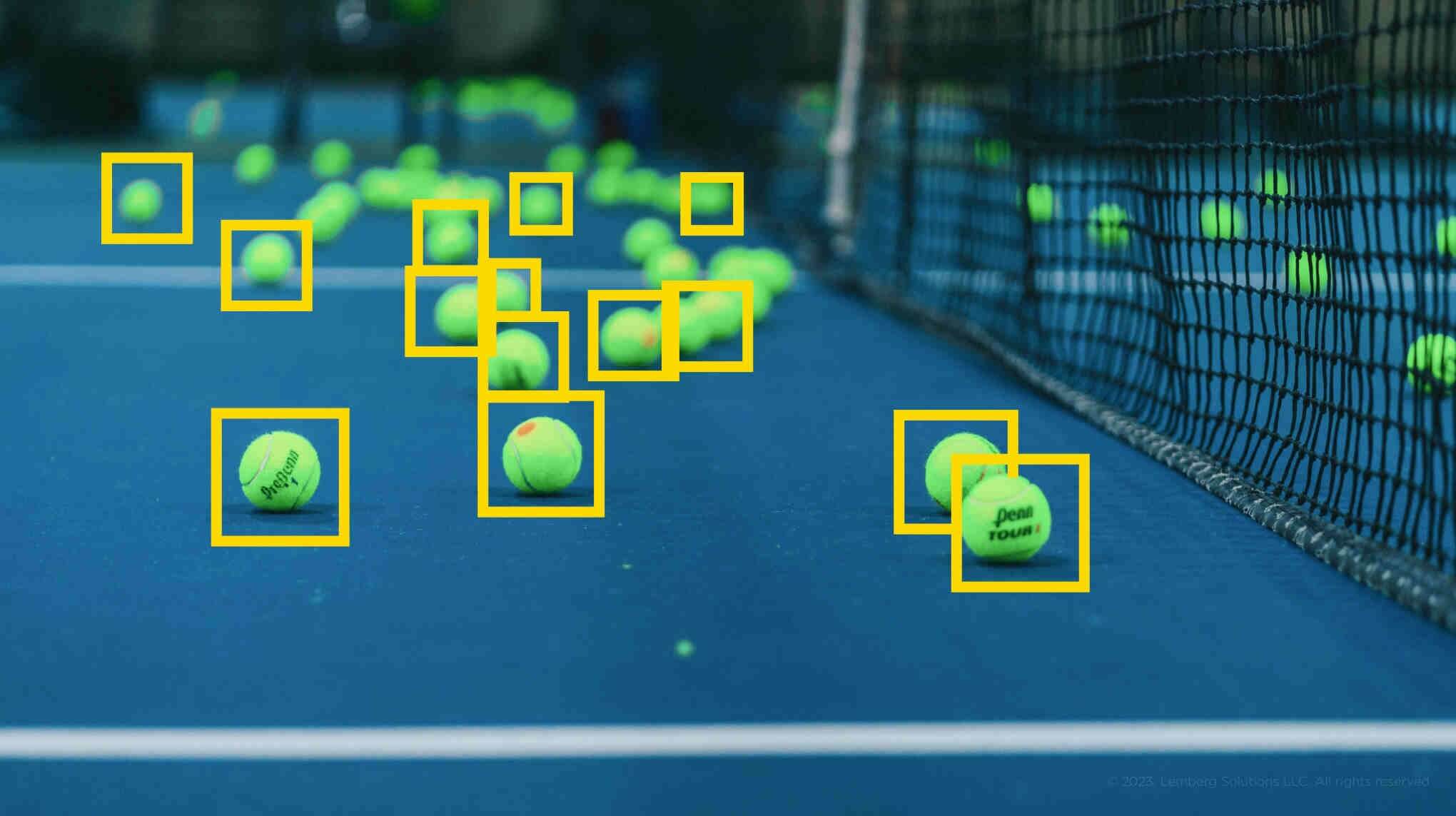
For computer vision solutions, 2D bounding boxes are the prevailing type of data labeling. Bounding boxes are rectangular frames that effectively identify the precise location of the target object. This is accomplished by specifying the coordinates of the lower-right corner and the upper-left corner of the frame. Data scientists usually apply this type of image labeling for object detection and localization tasks since it proves to be helpful in pinpointing the objects of interest.
3D cuboids
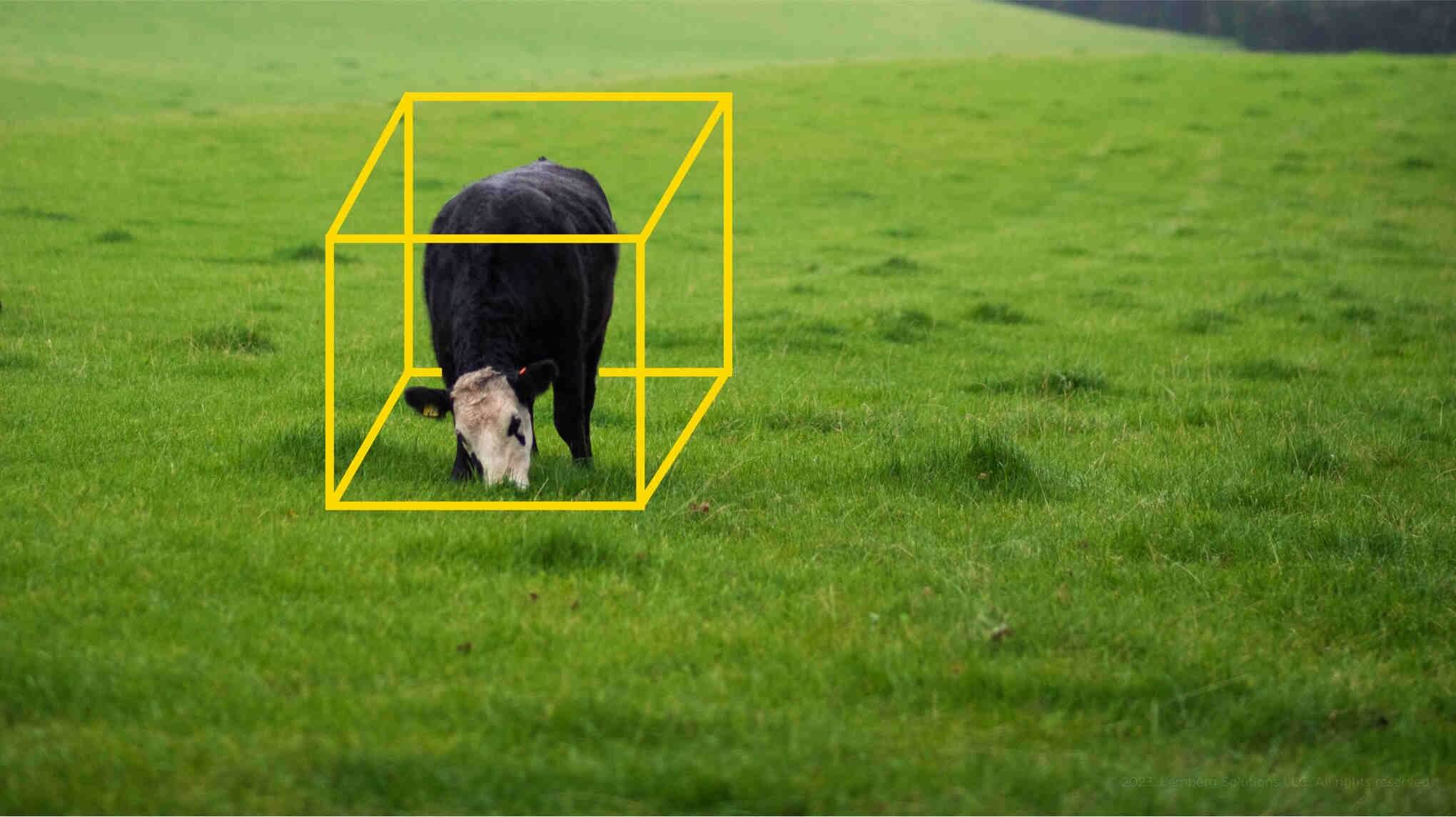
3D cuboids offer more dimension by providing valuable depth information about the target object. 3D cuboids enable ML models to discern intricate features, such as volume and precise positioning within a three-dimensional space. This type of image labeling is especially useful for the automotive industry, particularly self-driving cars. The depth information offered by 3D cuboids enables an ML model to accurately gauge the distance between surrounding objects and a car. Self-driving cars can make informed decisions and navigate complex environments with improved safety and efficiency.
Point and landmark

Point-and-landmark labeling helps to detect details and shapes of target objects by strategically placing dots on them. This type of labeling ensures that an ML model recognizes distinct data points, which is useful for identifying and analyzing facial expressions, body parts, and emotions. By accurately mapping the key points, ML models understand and interpret human-centric imagery. This type of image labeling is used when you need to precisely identify subtle details for comprehensive analysis and decision-making.
Lines and splines
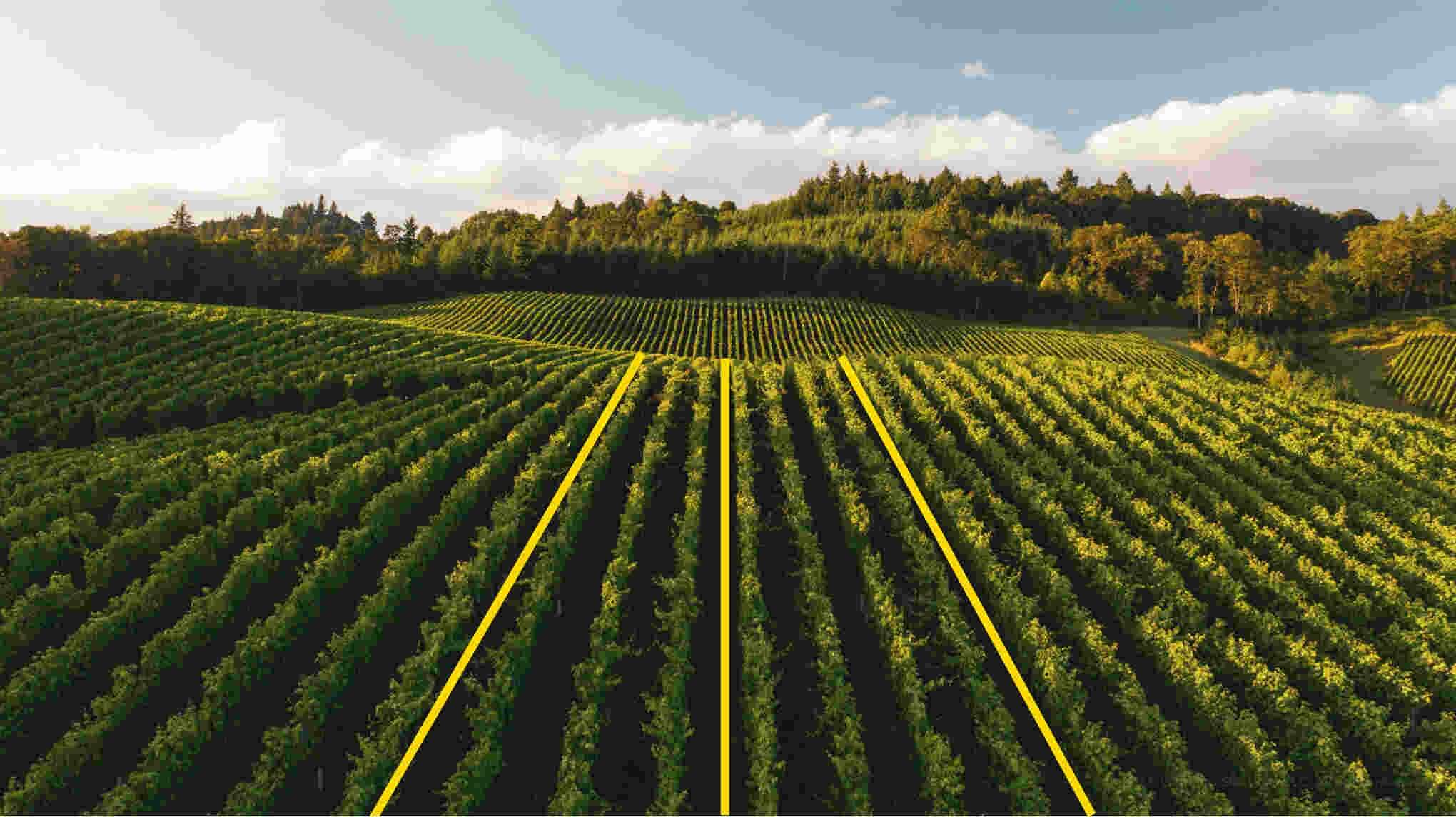
Lines and splines type of labeling involves strategic use of lines and smooth curves that enable AI-powered solutions to perceive and identify lane boundaries on the road accurately. With these labels, data science engineers train ML models that can be used in self-driving cars to navigate them, ensure safe driving within designated lanes, and effectively respond to changing road conditions.
Polygons

Target objects may vary in shape, which makes bounding box labeling challenging for curvy objects. Polygonal labeling helps to tag various objects of different forms, which enables an ML model to locate them more accurately. Polygons may be used for semantic and instance segmentation. For semantic segmentation, data labelers assign each pixel of the image to a specific class holding a distinct semantic meaning. These classes may include such objects as cars, pedestrians, sidewalks, and more. Semantic segmentation is useful when environmental context plays a crucial role. In instance segmentation, labelers assign specific labels to target object instances. ML models can make informed decisions and ensure safe and efficient interactions with their surroundings since they understand the context of their operation due to semantic and instance segmentation.
Video labeling
Classification

Video classification is a type of data labeling where data labelers assign objects on the videos to specific classes. Video classification allows training an ML model to identify the object on a frame.
Object detection

While labeling the videos for object detection, labelers localize and identify target objects for each video frame. Using this data labeling type, they train a model to identify objects, their location, and number.
Semantic segmentation

Semantic segmentation labeling for videos includes identifying the pixels with similar semantic meaning and assigning them to a specific class. This type of labeling allows a model to recognize the objects and their location.
Instance segmentation

With instance segmentation, data scientists label instances on each video frame the way that allows the model to recognize their presence and boundaries. This type of labeling enables an ML model to identify the object’s presence, location, number, size, and shape.
Audio labeling
Audio labeling helps ML models recognize the context of the speech or song to provide specific recommendations or analysis to end users. Audio labeling allows the model to differentiate between the speech and background noises, which makes it more effective.
Transcription
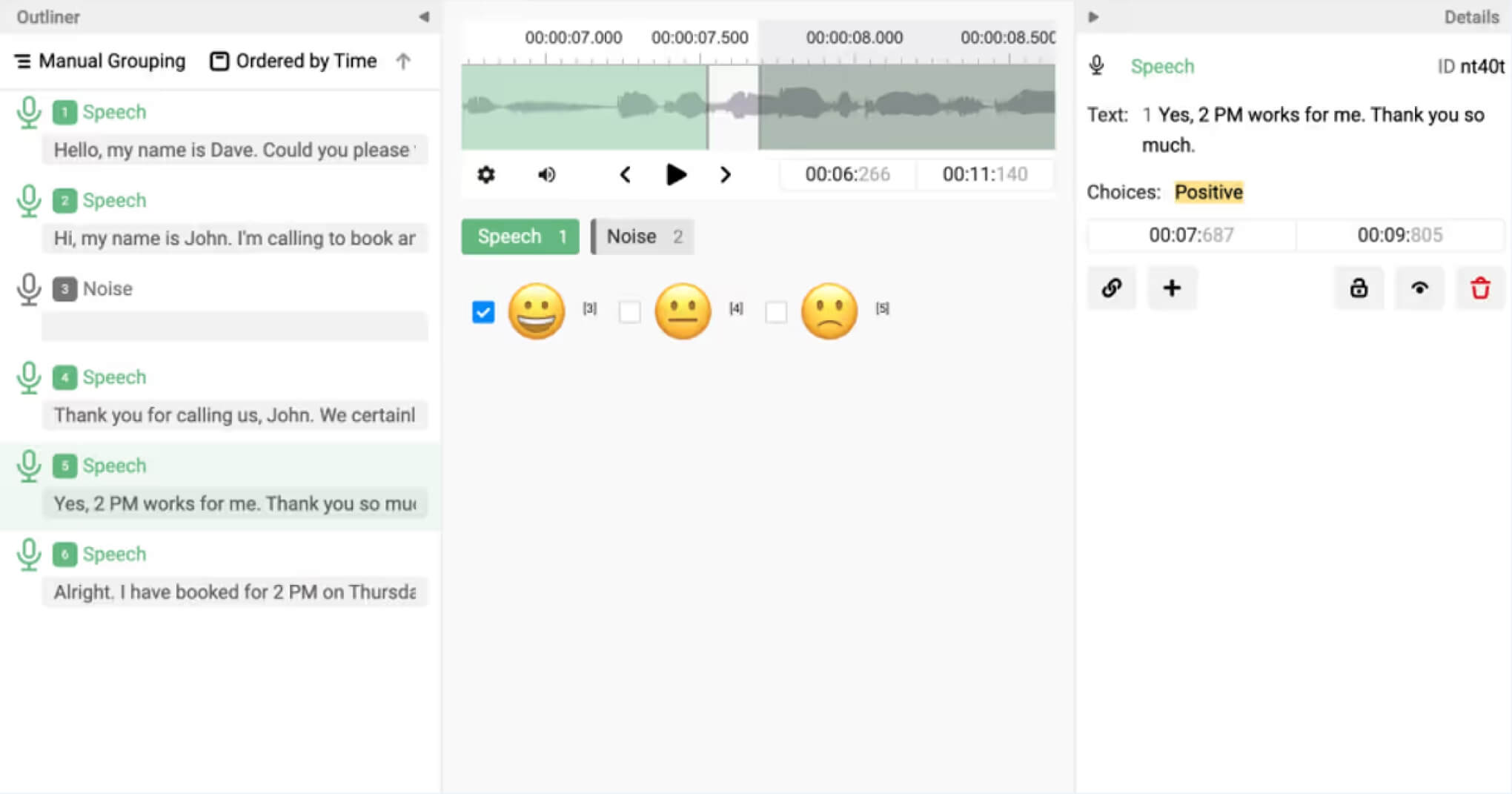
Source: Label Studio
Transcribing data for audio recognition is extracting the information from audio files and putting it in the form of text. Data labelers classify the files based on the language, dialects, context, and background noises. This allows for improved language processing and speech recognition. Such data labeling technique is especially useful for autonomous vehicles where the AI system has to recognize different accents and voice commands. Data science experts may even label background noises in a car to improve a user’s driving experience.
Named entity
Entity data labeling enables ML models to recognize the context of the speech more effectively. Named entity labeling trains a model to distinguish between parts of speech, target keywords, and proper names.
Text labeling

Text labeling process includes marking keywords and sentences to improve a model’s sentiment analysis and categorization. Data science labelers classify the data and provide sentiment labels that help the model to identify the text as negative, positive or neutral, as well as understand the topic.
Time series data labeling
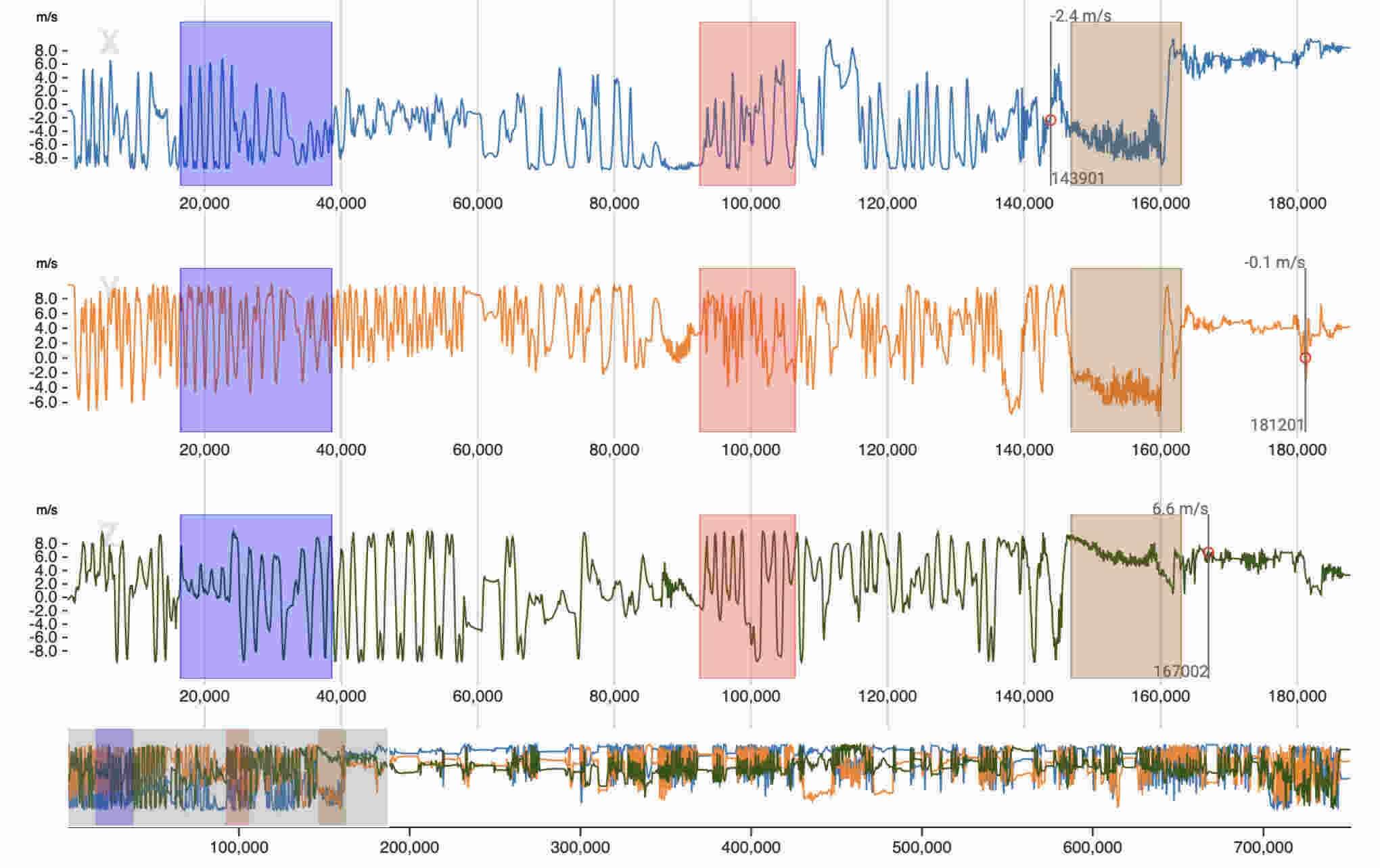
Time series data labeling involves working with the sequence of data, like temperature measurements and stock changes. This type of labeling allows to predict specific events. For instance, data labelers can label the temperature rates in production sites to train ML and DL models to predict the changes and notify the workers. Time series data labeling also helps train the models to detect any deviations in data sequence patterns and prevent risks.
We discussed the most common data labeling methods for different types of data, which data science experts usually apply while working on the projects. However, they can find unique solutions to make more custom ML and DL models work.
Core data labeling techniques and approaches
High-quality labeled data contributes to the accuracy of ML models. Models trained on properly labeled data are more likely to generate reliable results. Three common data labeling techniques include manual, semi-automated, and automatic labeling.
Manual data labeling
Data labelers frequently label data manually after collecting a dataset. They follow specific guidelines with requirements for labeling, which makes it more accurate and relevant for a certain project.
Even though there are plenty of machine learning data labeling solutions that automate the labeling process, data labelers still prefer manual labeling since it ensures more accuracy. Data scientists have better context understanding and handle complexities of patterns and classification better than automated programs. Manual labeling also allows you to provide ML and DL models with more specific industry knowledge that cannot be ensured by an automated labeling app.
However, manual labeling is time-consuming if the project requires labeling a large dataset. A data science team may also require more labelers to label the data, which can influence an ML model’s accuracy. Only competent engineers can make effective guidance that will allow to avoid disorganization in the labeling process. Moreover, if a project’s domain requires specific knowledge, engineers will need to find an expert who can consult them to make their labels more precise.
Despite any disadvantages, manual labeling is still a priority for data labeling experts as it allows them to achieve high accuracy and quality of the training dataset.
Semi-automated labeling
The semi-automated data labeling approach involves data labelers and automated applications to combine their efforts to create a reliable dataset. This technique helps to get the best results by leveraging the benefits of manual and automated labeling.
Semi-automated labeling starts with data science experts manually labeling a specific amount of data, which will later serve as data labeling example for automated apps. The apps label the rest of the data based on the manually labeled set. Next, an ML model recognizes which data isn’t accurately classified or which labels aren’t accurate. Data labeling experts use this information to label inaccurate instances manually and make the dataset more appropriate for training the model.
Semi-automated labeling allows you to save time and costs since automated programs assist in processing large datasets. Data scientists can provide accuracy with a subset of data which will help the automated app to label the remaining data more efficiently. However, if a prepared data subset isn’t accurate from the start, the rest of the data won’t be labeled correctly, spreading bias and errors. That is why it’s paramount to hire a professional data science team that can handle manual and automated labeling at the highest level of quality.
Automatic labeling
Automatic labeling doesn’t require much human supervision. Automated programs apply AI algorithms trained to label specific types of data, depending on the project requirements. Automatic labeling is usually suitable for large datasets.
Data science professionals choose pre-trained models and optimize them using the needed data and labeling a small dataset, which allows models to label the remaining data more efficiently. Automatic labeling still requires data scientists to check the labeled datasets and verify whether they have been processed correctly.
Automatic labeling ensures fast labeling of large datasets and is more time-efficient than manual labeling. This approach is more appropriate for scalable projects. It maintains consistency and helps to reduce human error. Data labelers apply automatic labeling for repetitive patterns. Nevertheless, automatic labeling can be inaccurate and needs human intervention to check the efficiency of the labeled data. Automatic labeling is less precise in terms of context that only humans can provide.
All three approaches prove effective in different cases. Data scientists can rely on automated programs if the task includes repetitive data. However, they still need to verify the accuracy of the dataset, which makes manual labeling more reliable from the start.
8 steps of the data labeling process
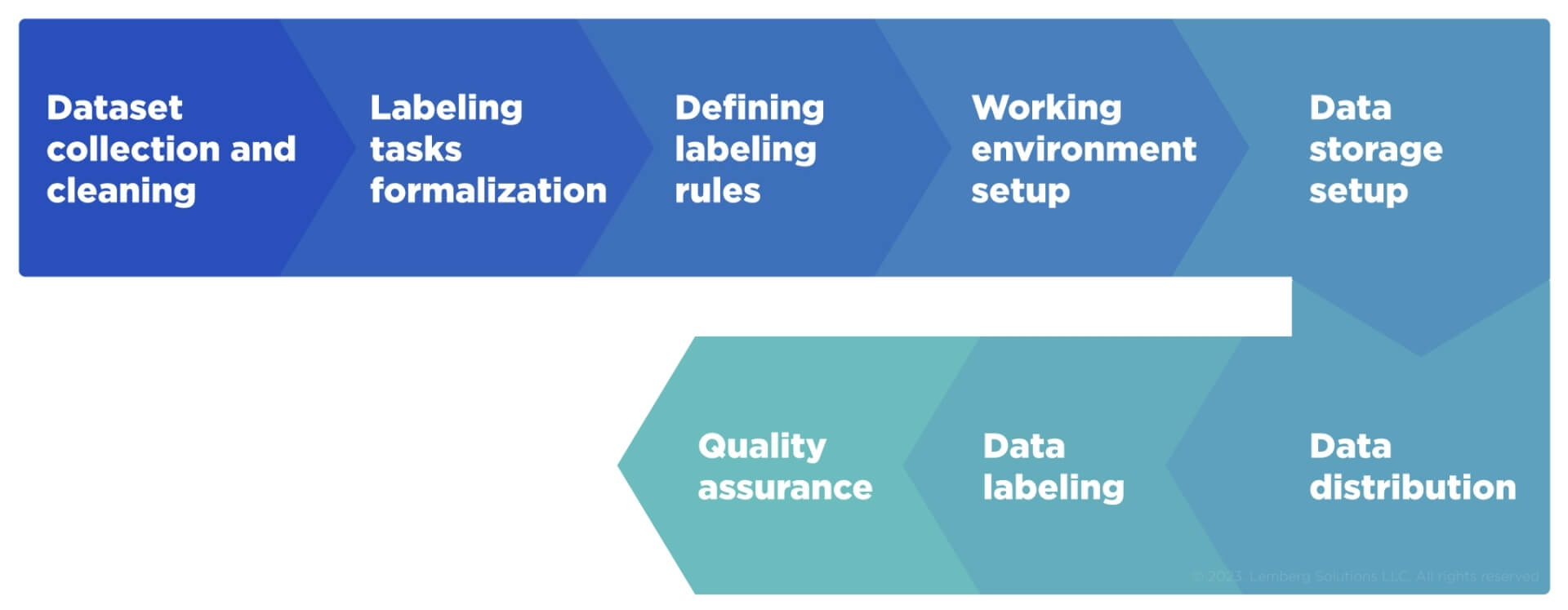
Labeling data for machine learning is one of the most important tasks of the data science project. That’s why our engineers share how to label data for machine learning models in the following steps:
1. Dataset collection and cleaning.
Proper data is key to a project’s success. That’s why our engineers pay attention to the information they gather and focus on real-world scenarios in which ML models operate. This way, we reduce the risk of errors and biases that affect a model’s accuracy.
2. Labeling tasks formalization.
To ensure that data labelers can label the data consistently, we define labeling tasks that cover project requirements. Labelers can maintain the consistency of labeling by following the formalized approach and staying within the project scope and budget.
3. Defining labeling rules.
Before labeling the dataset, engineers discuss the basic data processing rules. For instance, if labelers need to label a set of images with specific target objects using bounding boxes, engineers decide how to number the boxes. They can also agree on the annotations of the context to ensure that an ML model won’t be affected by any bias or inconsistencies.
4. Working environment setup.

When our data science engineers start working on a project, they always ensure they have all the needed tools for AI data labeling. They search for suitable software platforms or develop custom programs to make the process efficient. Our team communicates with the client to provide feedback and make sure they align with the client’s expectations. If the dataset is large or complex, our data scientists undergo special training to handle challenging tasks.
5. Data storage setup.
Our data science team ensures that they have the necessary access to the data. We set up a secure data storage suitable for sharing data, controlling versions, and managing access.
6. Data distribution.
The dataset is distributed among the team members with the most experience in particular projects. We ensure that our experts can handle the data labeling process with maximum efficiency.
7. Data labeling.
After all of the previous steps, our data labelers start labeling the data while complying with the ML engineer’s instructions. This approach ensures that there are no errors and biases in the dataset.
8. Quality assurance.
Our data science experts check whether the labeled data is accurate and consistent. They share their feedback and correct any errors during the data labeling process. Quality checks prevent falsely labeled data from being included in the training dataset.
A proper data labeling process ensures the accuracy and reliability of training datasets. It is fundamental for the development of trustworthy and effective ML models.
Challenges in data labeling
The most encountered challenges in data labeling include labor intensity, expertise requirements, inconsistency, context annotation, and data security. Addressing these challenges effectively is crucial for obtaining high-quality labeled data, which affects the ML model’s performance.
Labor intensity
Since the best way to make your labels accurate is to process data manually, the labeling process is labor intensive, especially when data scientists deal with large datasets. Manually adding labels for target objects on each separate data item is complex. However, the more expertise a data labeler has, the faster and better they will handle the task.
Industry expertise requirements
Each domain requires specific nuances knowledge to label the target object accurately. For instance, if labelers work on a healthcare project and need to label tumors to develop a recognition algorithm, they will most likely need to hire a domain expert. This way ML model will be accurate. Usually, domain experts help at the beginning of the project, checking the initial data subsets and how the ML model handles the task. Data scientists can label the remaining dataset based on the subset verified by an expert.
Inconsistency and bias
Labeling large datasets requires several data science experts to perform the task. Each team member can find different solutions to label the target objects, which leads to a messy training dataset as a result. They can have certain disagreements in terms of labeling rules and approaches. That is why our data science team chooses one engineer responsible for labeling coherence. They check whether the instructions are clear and ensure all team members follow the predefined rules for labeling.
Context annotation
Some data science projects require labeling complex data in terms of context that needs to be annotated for an ML model’s accuracy. For example, if a client needs a computer vision system that recognizes human emotions, labelers will add specific tags that define each emotion. Such a project demands engineers to reach an agreement on the sentiment that target objects express. Personal interpretations may become a significant obstacle since an ML model cannot operate efficiently if there are any data contradictions. Data scientists will need to agree on certain guidelines and rules as well as verify them with the client.
Data security
Data science projects involve sensitive data. Secure methods of data storage for further labeling and training are a priority for data science engineers. They implement proper encryption and access controls to make sure the data is protected.
At Lemberg Solutions, we protect data both on the company and project levels. In addition to ISO/IEC 27001:2013 and ISO 9001:2015 certifications that prove our data security practices, we assign project managers who allocate access control on each project. We discuss data storage conditions with a client who decides whether their data should be stored within their server or in our data storage system. Besides, we regularly review data and access control to ensure constant protection. We sign a DPA with detailed requirements and regulations on data usage, processing, and storage as per the client’s request. Our company doesn’t store the client’s data locally on employees’ personal computers. Moreover, we maintain workstation security at all times.
Navigating the challenges we’ve discussed requires a combination of careful planning, process optimization, leveraging proper software, and continuous improvement strategies.
Our data labeling expertise and projects
Embedded vision prototype for livestock weight monitoring
We developed an embedded-vision-based system for livestock weight monitoring for a Ukrainian agricultural company that specializes in growing pigs and cattle. Weight monitoring is crucial for effective farm management as it allows farmers to track livestock health and select feeding. Manual weighing is labor-intensive, and our client has needed multiple people and many hours to weigh animals one by one. This problem made our client look for a solution to automate daily pig-weight monitoring and reduce manual operations at farms.
Our data science team collected the data on the farm and established data labeling rules. Our data labelers created segmentation masks to train an ML model detect and count the pigs for further weight measurement. We also used keypoints and bounding boxes to label the target objects and help the model recognize their size. Read the full case study.
Text recognition AI solution

Our client wanted to create an AI solution that recognizes and analyzes text on the images. They searched for a data science team that could help them label the data for ML model training.
Data scientists at Lemberg Solutions requested the needed data and discussed the client’s goals. Our data labelers leveraged bounding boxes method to label the letters. After the bounding boxes were created, we labeled the class of each frame to help the ML model identify the letters.

Takeaway
By diligently following useful approaches and considering the specific challenges of your AI project, data science experts work to ensure that the labeled data they generate is as accurate as possible. This accuracy, in turn, is a fundamental pillar supporting the success of subsequent ML model performance. Creating a practical data labeling process is crucial for dataset quality and model efficiency. The data labeling process should be clear, so that each team member understands the guidelines and rules.
At Lemberg Solutions, our data science engineers have years of experience and numerous successful projects completed. We have worked in different industries, including healthcare, retail, manufacturing, and transportation. Don’t hesitate to contact us for consulting to discuss your data science project needs and find the solution together.


